Orchidaceae, otherwise known as the orchid family, one of the most expansive and diverse flowering plant families in the world, contains tens of thousands of known species.
Orchid plants well known for the beautiful flowers but are also intimidating to own! If you’ve always loved orchids from afar but want to bring one into your home, you’ve come to the right spot.
Today I’ll be sharing all you need to know about how to care for your indoor orchids from the right conditions to different types of orchids so you can enjoy them for years to come.
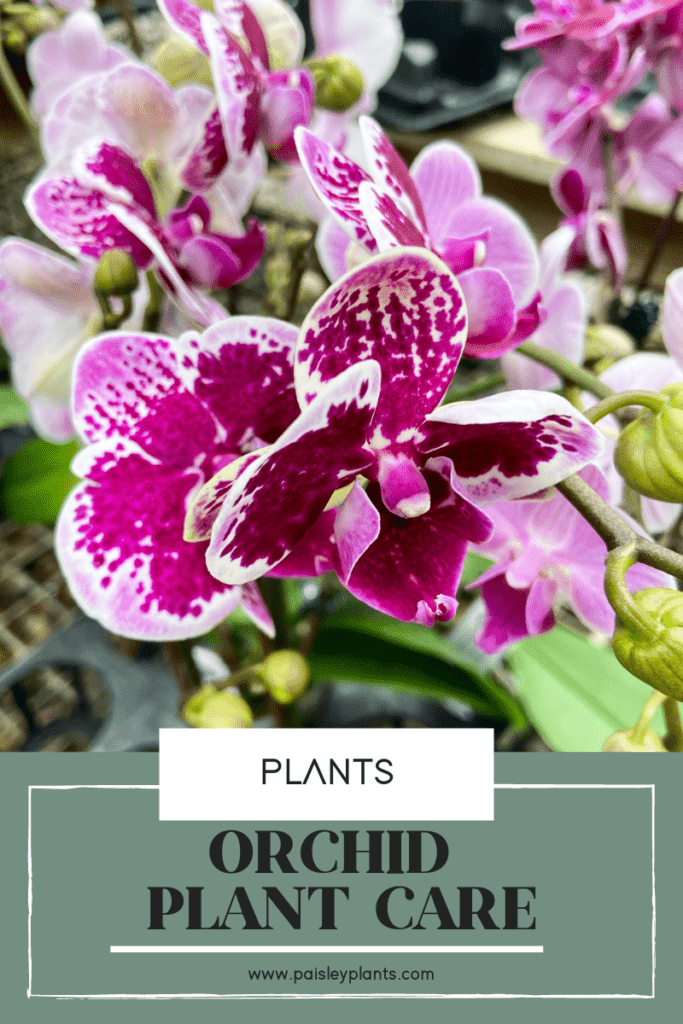
This post includes affiliate links.
Table of Contents
Background and History
Orchids have been around since prehistoric times. Scientists are now hypothesizing, based on fossils and genetic sequencing, that primitive orchids may date back over 100 million years.
Their ability to hybridize and adapt to different climates and terrain may explain their longevity and why they are found on every continent, excluding the frigid Antarctica. The flower’s origin may even be older than the division and drift of the continents, another theory that could explain their ubiquity across the globe.
Common Names
The actual term ‘orchid’ was coined by John Lindley in his 1845 work School Botany, an abbreviation for the family it belongs to, Orchidaceae.
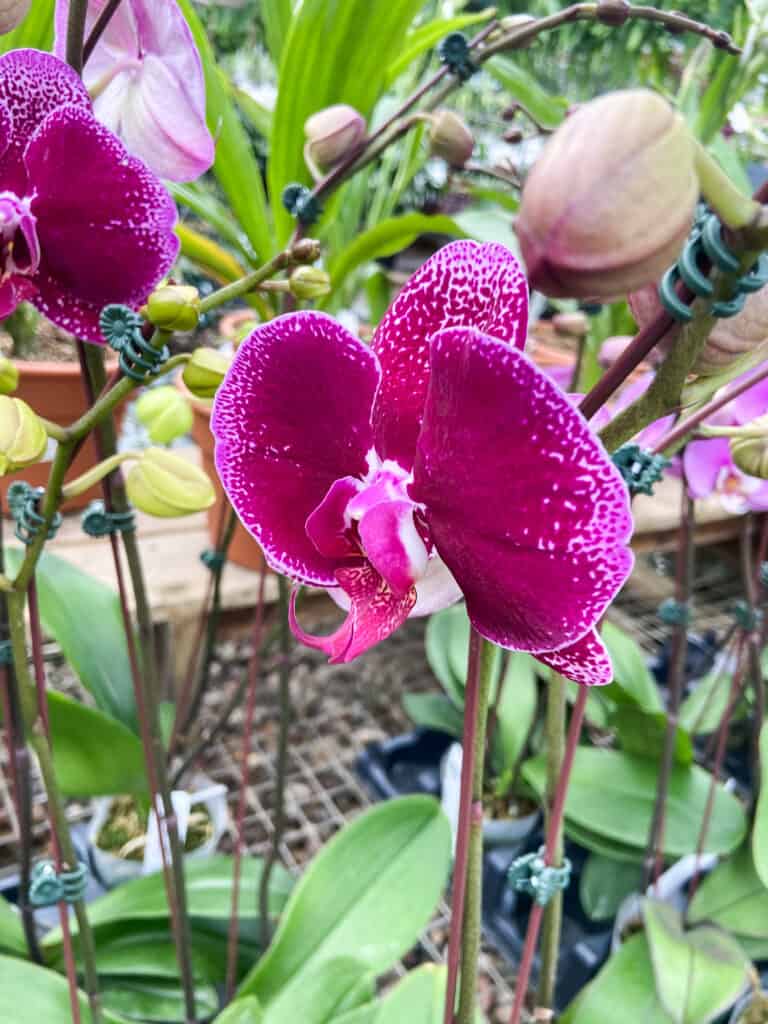
Many orchid varieties have common names because the Latin nomenclature is just too darn difficult to remember and pronounce. Seriously though, the common names group together similar species under recognizable terms by describing their looks, special features or growing habits.
And common names do make it much easier to recall and refer to certain types. Listed below under varieties are some common names alongside their Latin genus descriptors.
Types of Orchids
There are over 28,000 known orchid species of orchids around the globe. Needless to say, we’ll barely scratch the surface of the varieties available. However, there are multiple types that are well suited for home gardeners to cultivate on their own.
Here’s a list of some popular varieties based on ease of growth, durability, practicality and of course their inherent beauty.
Lady’s Slipper Orchid Cypripedium calceolus
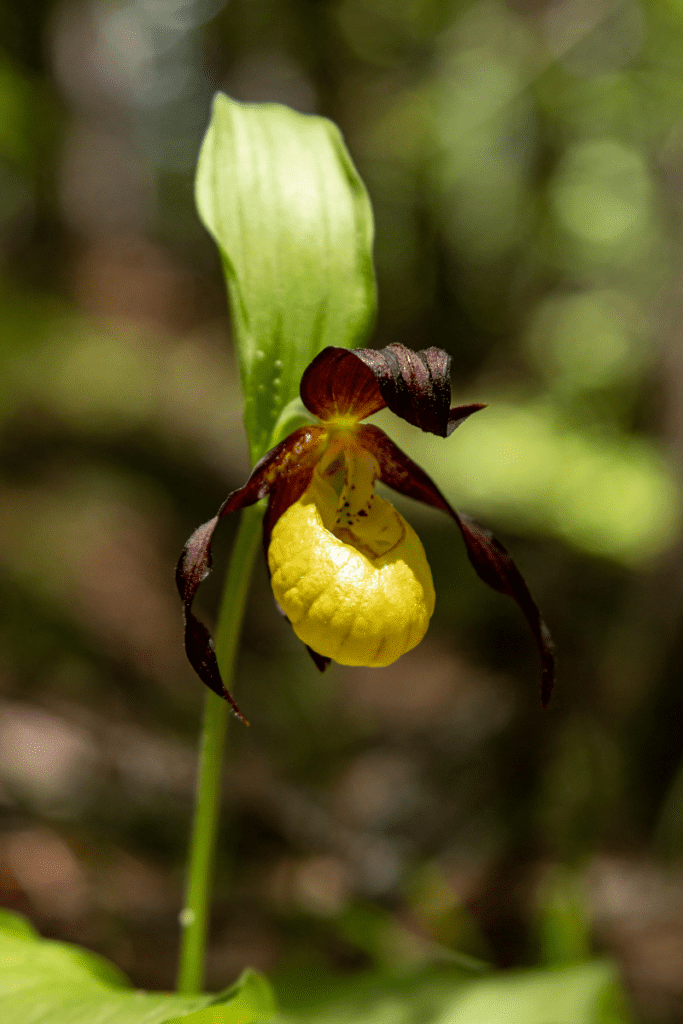
As one would guess, the blooms of this type of orchid are likened to small yellow slippers. They are native to Asian and European forests, where they are a protected species.
Lady’s Slippers are not difficult to grow but do require a decent amount of sun exposure. They will thrive in outdoor landscapes of northern regions and bloom during the spring and summer months.
Venus Slipper Orchid Paphiopedilum
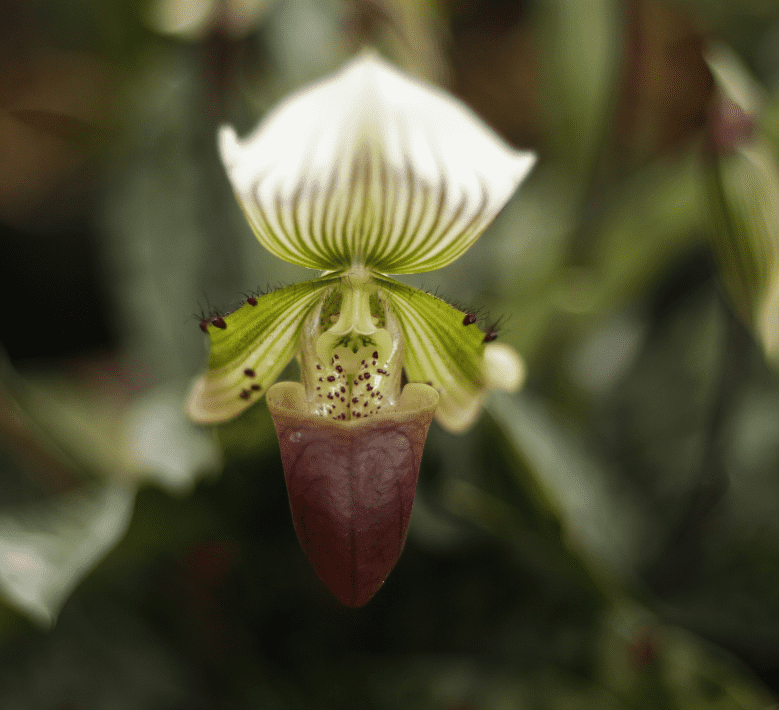
The 80 or so species of the Paphiopedilum genus are dainty natives of tropical climes. Propagation by means other than seed is quite difficult, making each Venus slipper orchid a distinct individual.
Typically these orchids will shoot a singular white flower showcasing purple and green marks on the petals. Because of their delicate nature, it’s best to keep this variety as a houseplant.
Miltonia Orchids Miltonia
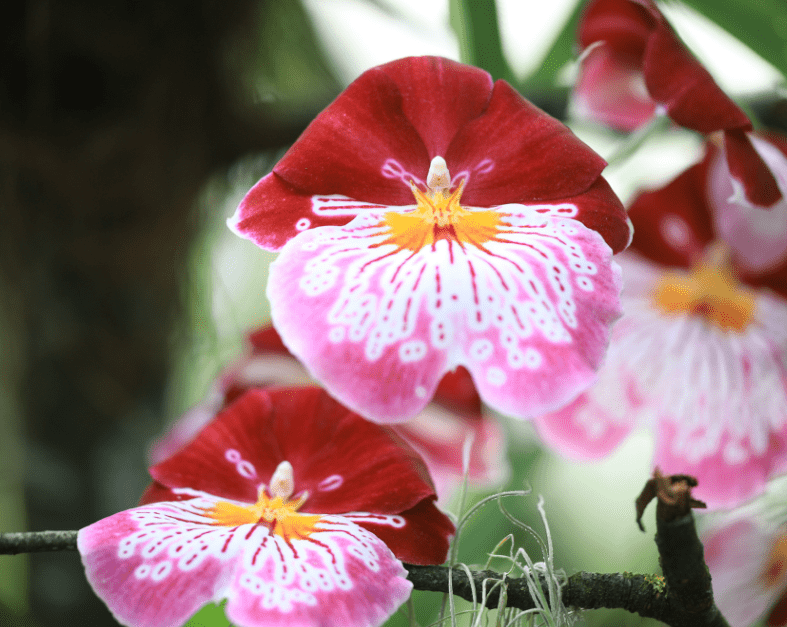
Often referred to as pansy orchids, miltonia will do best kept as houseplants. Native to Central and South America, they prefer bright sunshine.
It may be a bit difficult to get them to bloom, but it is well worth it when they do. Large, lovely blossoms appear in the spring and fall and will add interest and brighten up any space in the home.
Epidendrum Orchids Epidendrum
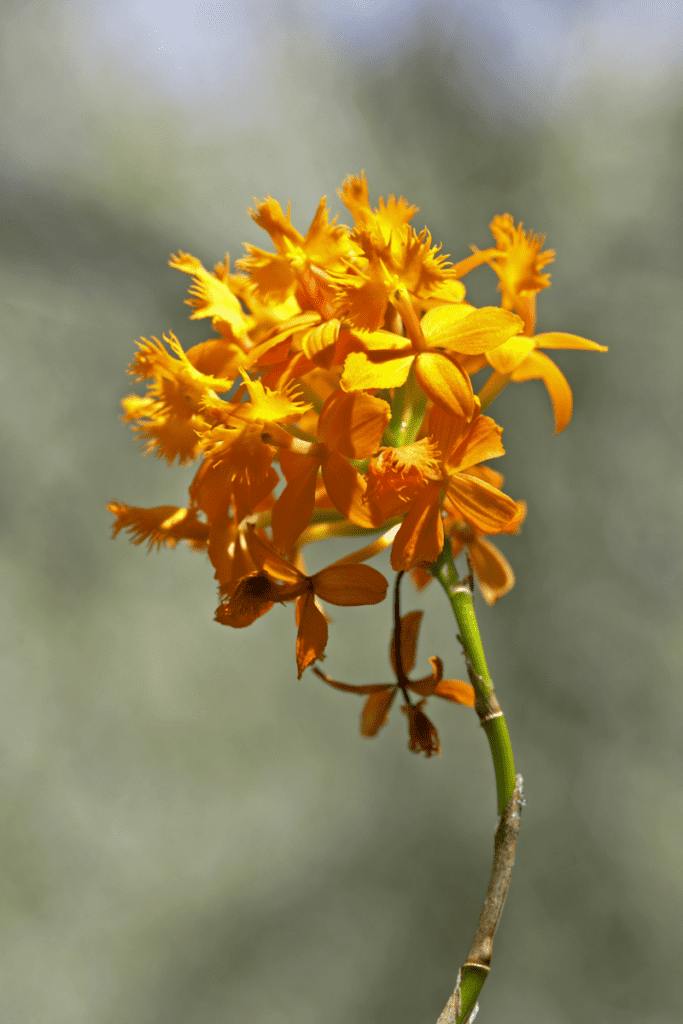
Epidendrum orchids feature clusters of small flowers in brilliant oranges, yellows and reds. The pattern of the petals are likened to crosses and the flowers are aptly referred to as crucifix orchids.
The nearly 1,500 species of this particular genus are native to tropical and subtropical regions in North and South America. They are easy to care for inside the home but also make a fascinating display in outdoor gardens, if its preferred tropical climate is available.
Fox Tail Orchid Rhynchostylis gigantea
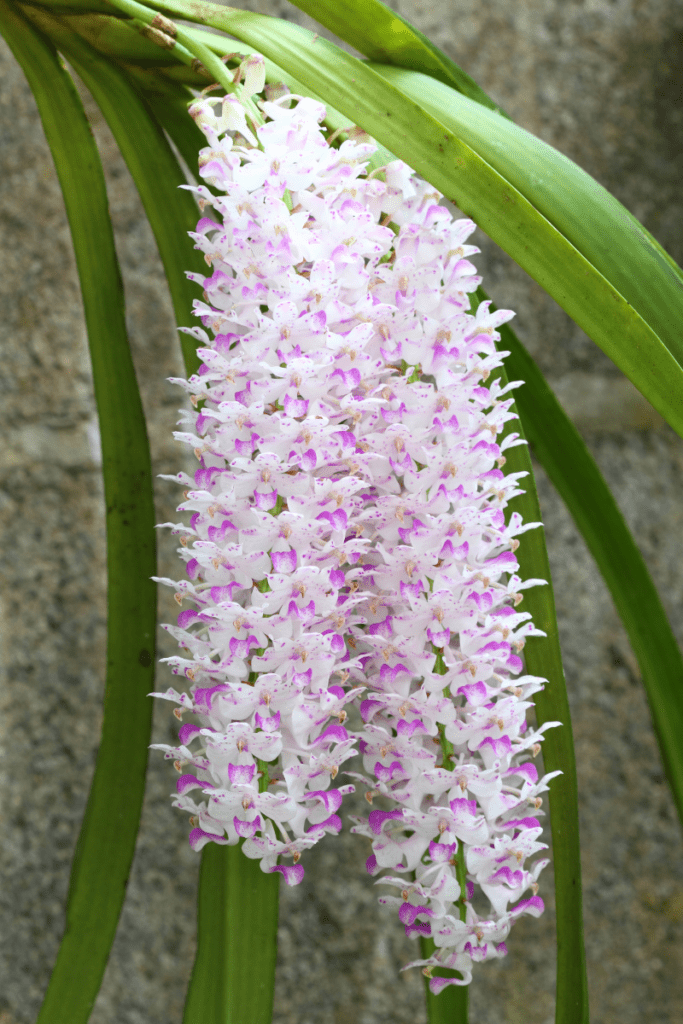
Grown as a houseplant, the foxtail orchid produces florets of blossoms about 15 inches long. It is native to Southeast Asia and India and widely distributed around the continent. In full bloom the flowers of red, white and magenta resemble a puffy foxtail.
Cat’s Tail Orchid Aerides
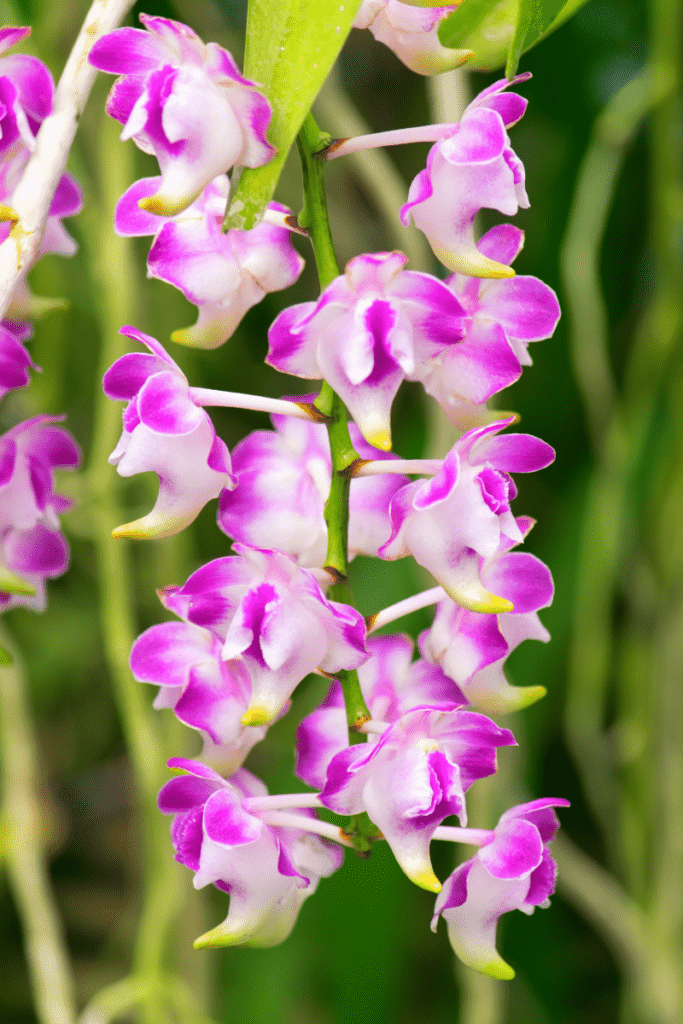
Racemes studded with multiple brilliantly colored flowers are a sight to behold. As a native to tropical Asia, this variety will bloom in the summer and do an excellent job of brightening up the home with yellows, whites, pinks and purples.
Monkey Orchid Dracula simia
Native to South America, these adorable brown and white flowers will grow well in the home or in the outdoor gardens of warmer climates. Blooming throughout the year, growers will go bananas for the delightful blossoms that strikingly resemble miniature monkeys.
They prefer shade and can be a bit difficult to grow, but the cheerful flowers and citrus aroma make it worth your time and effort.
Tiger Orchid Grammatophyllum speciosum
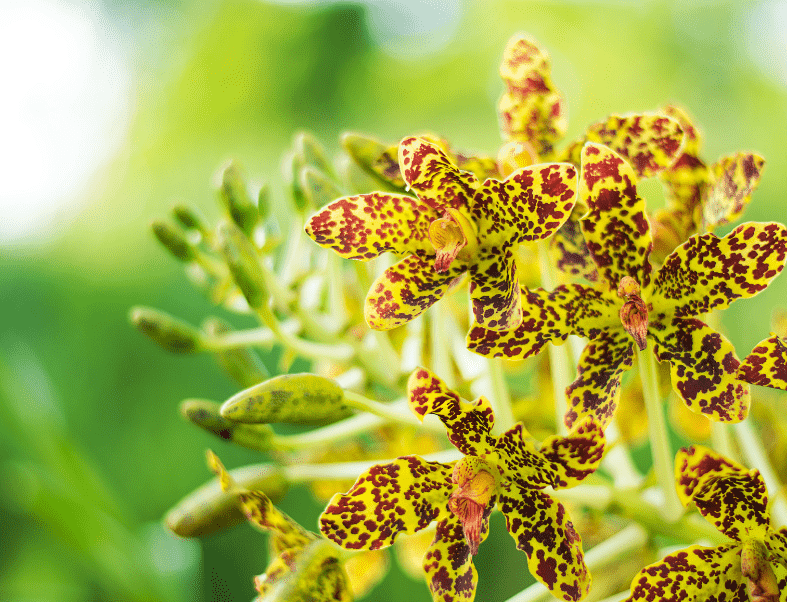
The bunches of yellow flowers featuring leopard spots and brown tiger stripes are simply spectacular. Because they’re quite difficult to grow, tiger orchids should be kept as houseplants.
The plants themselves can grow to incredible heights, giving them the alternate nickname ‘giant orchid.’ Any gardener up for a challenge will certainly be rewarded by growing this impressive and unique cultivar.
Vanilla Orchids Vanilla

Have you ever wondered where the delicious flavor of vanilla comes from? These tropical plants are not only easy on the eyes, but also produce the seed pods from which the essence of vanilla is extracted.
Vanilla planifolia is the specific variety cultivated for the desirable pods. Try to mimic natural conditions in order to force the plants to bloom and produce seed.
Vanda Orchids Vanda
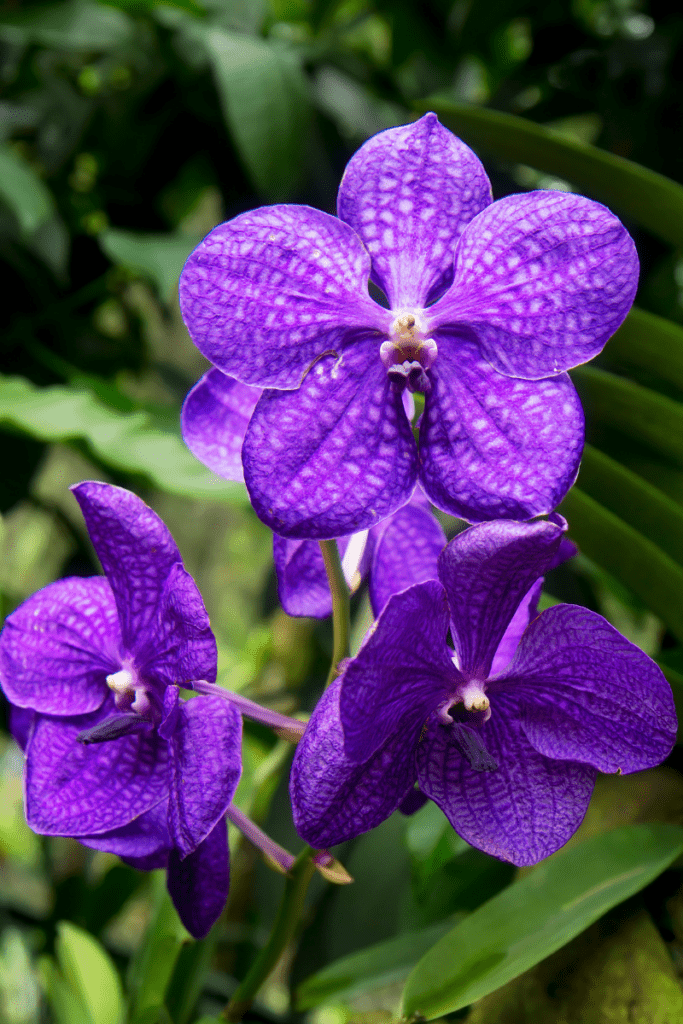
Vanda orchids are popular and easy to find and care for. They bloom beautiful and enduring flowers multiple times per year. With a pleasant aroma and a variety of vivid colors available, it’s easy to understand their popularity. Vanda orchids will happily grow inside or outside in warm climates.
Other popular varieties include Cattleya, Dendrobium, Cymbidium (common name boat orchids), and Phalaenopsis Orchids (common name moth orchids).
How to Water Orchids
Understanding the biology and basic functions of orchids will help growers water properly. Each individual species has its specific preferences as to how it prefers to be watered.
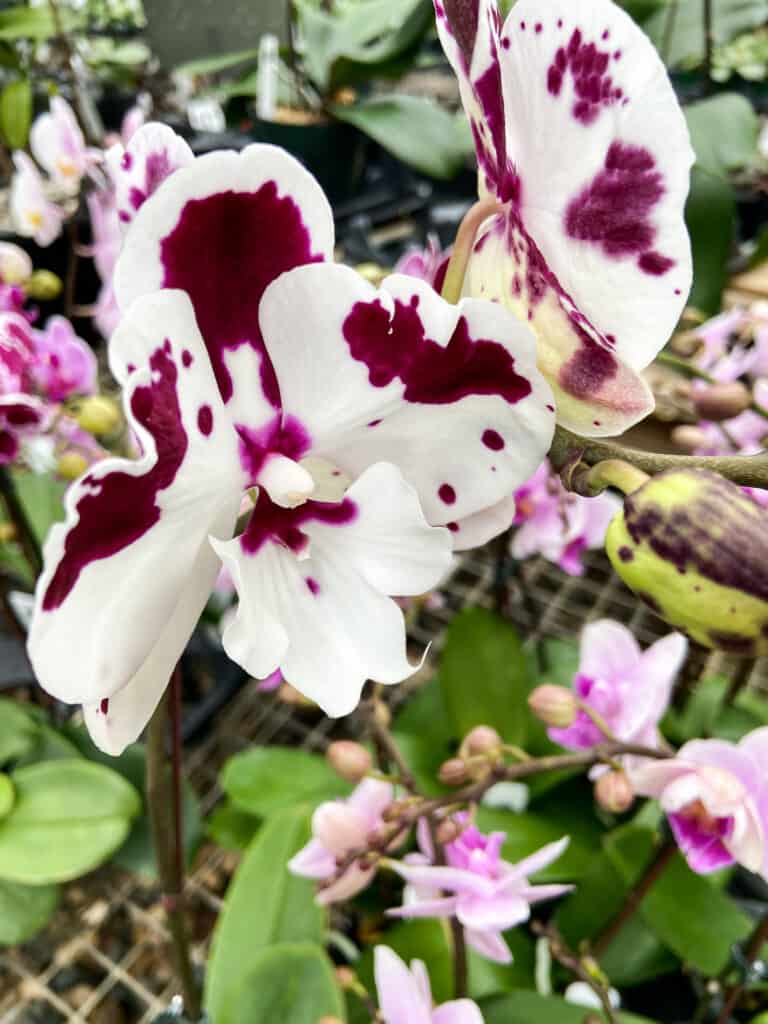
It can be tricky trying to perfect the process, but it can be well done by knowing what you’re looking for and paying attention to detail. Orchids, like many plants, would rather be a bit under watered than overwatered. Too much water can quickly lead to root rot and death of the plant.
Orchid roots are covered by a thin outer tissue called velamen. This membrane quickly soaks up water, latches on to rough surfaces and absorbs minerals and other nutrients. When dry, velamen is a white or silver color. When it’s moist, velamen usually appears green or speckled.
Mistakes that should be avoided are watering too frequently and watering in the evening. Never let your orchid sit in standing water. Roots should be kept moist, but definitely not submerged under water.
Along the same lines, soaked roots in the evening can lead to bacterial and fungal diseases. A rule of thumb for all orchid varieties: Always water in the morning.
It’s extremely important to pay attention to the special needs of your specific variety, but there are a few universal rules that will generally lead to success.
When it comes time to water, do it thoroughly but without using excess water. Be sure that the velamen is sufficiently moist.
If you’re not sure if your orchid is ready for water, resist the temptation to give water. Most orchid varieties tolerate dry conditions much better than being soaked.
You’ve likely heard about using ice cubes to water orchids. While you won’t see this being done in nurseries or by professionals, placing three ice cubes in the soil of your orchid plant is an acceptable way to water it!
Obviously keep an eye on your specific plant and it’s needs if you try this method but it has been shown to be a good option when watering orchids.
Light
Another factor dictated by specific variety is the amount of required light, though there are some standard conditions that can be applied to most varieties of orchids.
Orchids will only bloom with adequate amounts of light. Direct sunlight may burn leaves and blossoms, plenty of bright indirect light is preferred.
Try setting your orchids in a south or east-facing windows. If you don’t have those, you can alway use artificial light such as a grow light.
By observing leaf color you may be able to determine your plant’s light needs and preferences. Bright green leaves are the sign of a healthy and happy plant. Dark green leaves indicate it’s not getting enough light. And yellow or red leaves mean your plant is getting too much light.
If this is the case move your orchid to an area with less light exposure. Or, use a sheer curtain or blind to filter the bright light. This will simulate it’s natural habitat and the canopy under which orchids typically grow in their natural tropical environment.
Soil
Keeping roots aerated is another effective way to replicate natural growing conditions for your orchids. They should never be planted in common potting soil. The roots would soon be smothered, suffocated or drowned.
Special orchid potting mixes can be found at most garden centers. These blends are usually made with fir bark chunks of differing grades, from fine to coarse.
Mixed in with the bark are various other ingredients; perlite, peat or sphagnum moss, pine cones, coconut chips or coir and horticultural charcoal, among others. You can of course experiment and whip up a batch of homemade mix using a combination of these materials. Use five parts bark to one part of each of the other ingredients.
The larger the roots of your plant, the coarser the growing medium should be to accommodate sufficient drainage and air flow.
Fertilizer
An old maxim of orchid growers is, fertilize “weekly, weakly.” At this rate, a standard 10-10-10 fertilizer at half strength should do the job. Orchids should be fed regularly during periods of peak vegetative growth, usually spring and summer. Differing from most flowering plants, fertilizer can be withheld during bloom. Feeding should also be foregone in the dormant winter months.
Be careful not to be too heavy-handed with the fertilizer. This can quickly lead to the buildup of salts and other minerals, creating an inhabitable, overly acidic environment for your prized flowers.
Of course always refer to the specific care instructions of the particular genera and species that you grow. I personally like this liquid fertilizer.
Temperature and Humidity
As a general rule, orchids grown indoors will be comfortable under the same conditions as their caretakers. Daytime temperatures of 75-85 degrees and night temperatures of 65-75 degrees are ideal. The humid environment is likely a bit higher than what’s in your home as they prefer levels to be at 40-70 percent to keep your orchids happy.
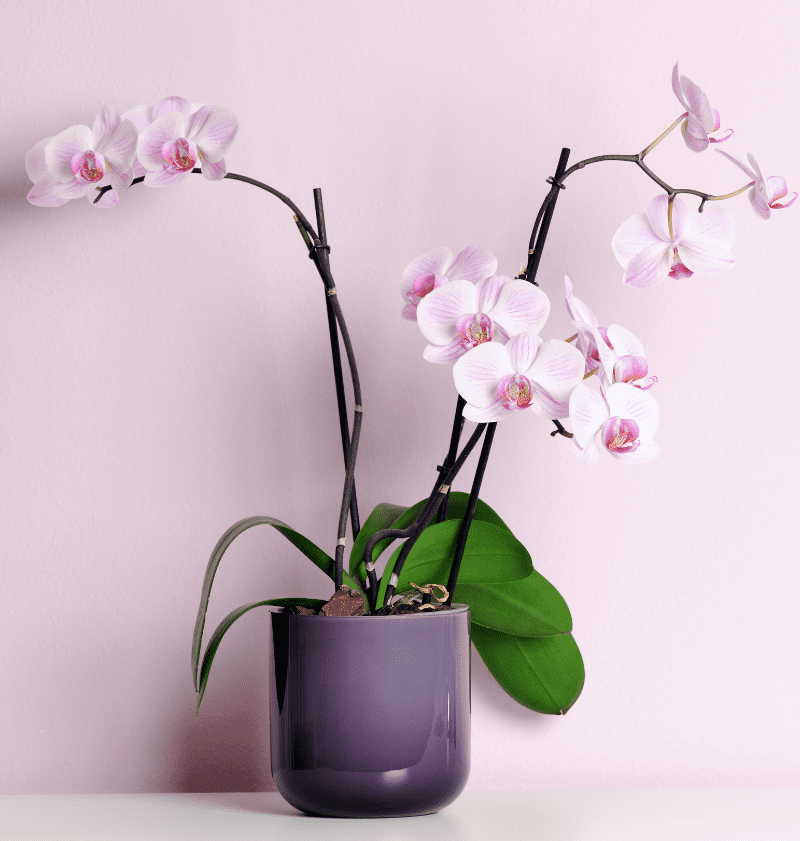
Invest in a cheap digital thermometer to closely track and keep the correct temperature and humidity. Use a humidifier or dehumidifier for the proper humidity levels for your orchid.
Toxicity
There are thousands of varieties of orchids, most of which have not been studied in this regard. For this reason orchids should never be ingested and it would be wise to keep them out of the reach of pets and children.
Although most common varieties of orchids are not toxic, Cypripedium aka Lady Slipper orchids are known to cause topical irritation and digestive distress to some people and pets. Growers should be aware of this potential and be vigilant if any severe adverse effects are experienced.
Also consider that fertilizers used on your orchids can be harmful if ingested. These should always be stored in an inaccessible location, away from children and pets.
Pests and Diseases
When kept healthy and strong, orchids will rarely encounter major pest or disease problems. That being said, there are a few issues that may arise and present negative consequences if left untreated.
Aphids usually attack and consume fresh new growth. Like many common pests, they are soft bodied and can be treated with neem oil or insecticidal soap.
Mealybugs may appear on top of the petals or columns and are small, white puffy bugs. Treat with neem or soap. Below is what mealy bugs look like.
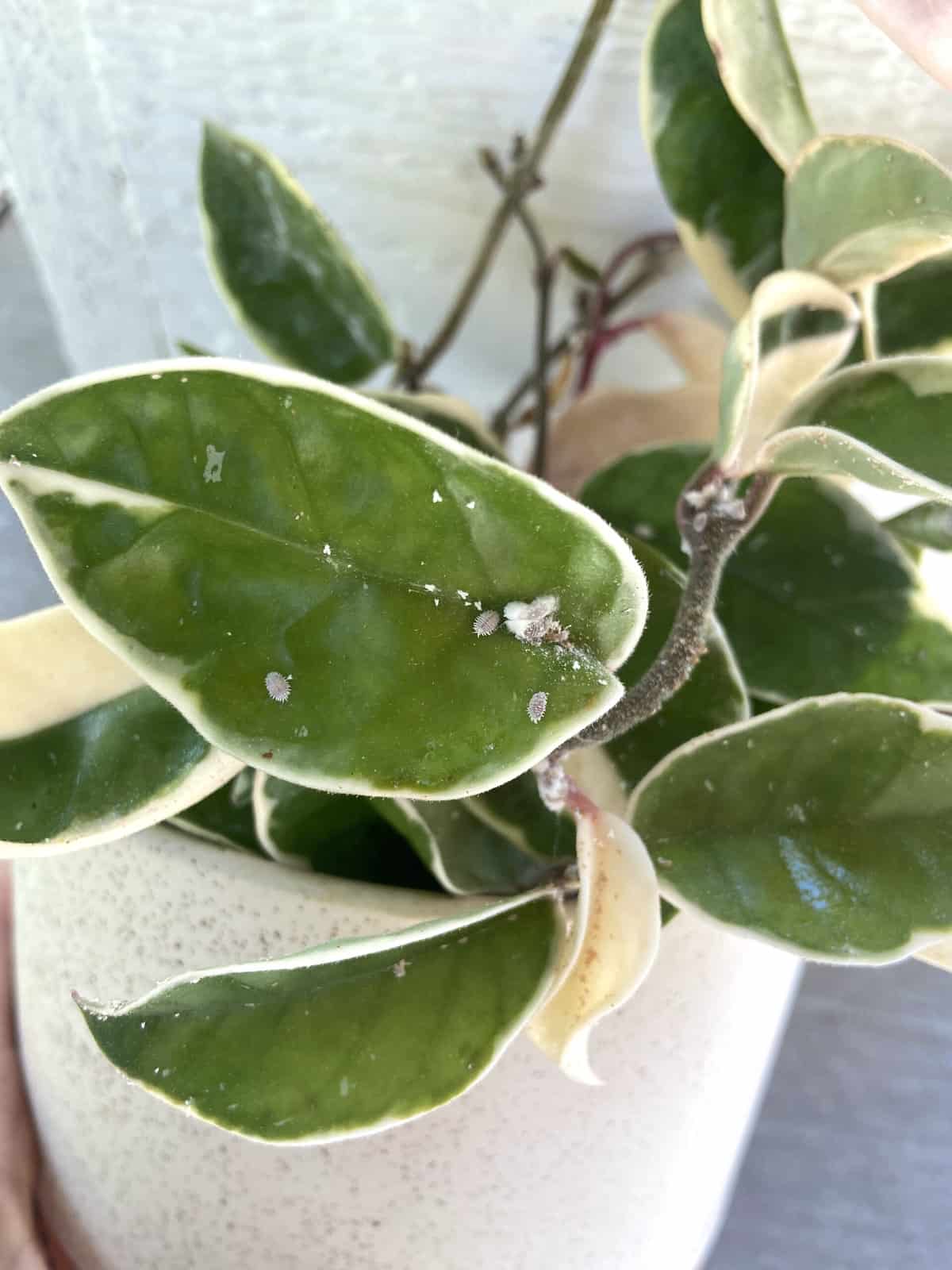
Spider mite intruders will build webbing on the underside of leaves. Wash them off with warm soapy water and continue to treat with neem and soap.
Root rot can occur if roots are kept too wet for too long. With proper watering and airflow roots should remain healthy and strong.
Leaf spot is caused by fungal or bacterial diseases and shows up as round or oblong blotches on leaves or flowers. Carefully cut off affected plant parts. Always sanitize tools after dealing with infections in order to prevent the spread of disease.
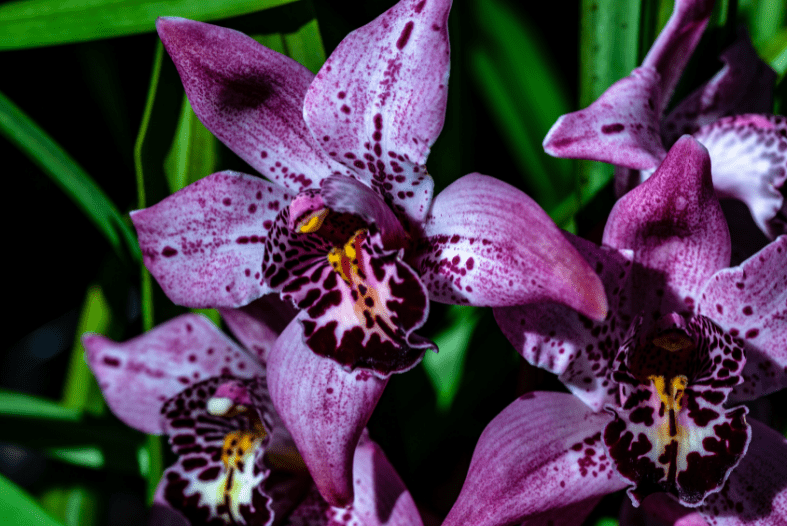
Crown rot is due to the collection or settling of water in the central growing point. The crown will become black and rot out. It is usually not possible to save the plant after infection.
Pruning and Repotting
Pruning your orchids is a technique that requires attention and care. When executed properly it will help keep plants healthy and encourage more blooming.
The best time to prune is after flowers have dropped off the plant. Prune only as often as this process occurs.
Carefully inspect your orchid, noting any areas that need pruning. If the flowers have fallen and there is enough time for the plant to set another round of buds and blossoms before the dormant season, cut the flower spike back to an inch above a node.
If the spike is healthy but the dormant season is imminent, cut the entire flower stalk down to one inch above the base of the plant. Make sure to cut above and leave any present nodes.
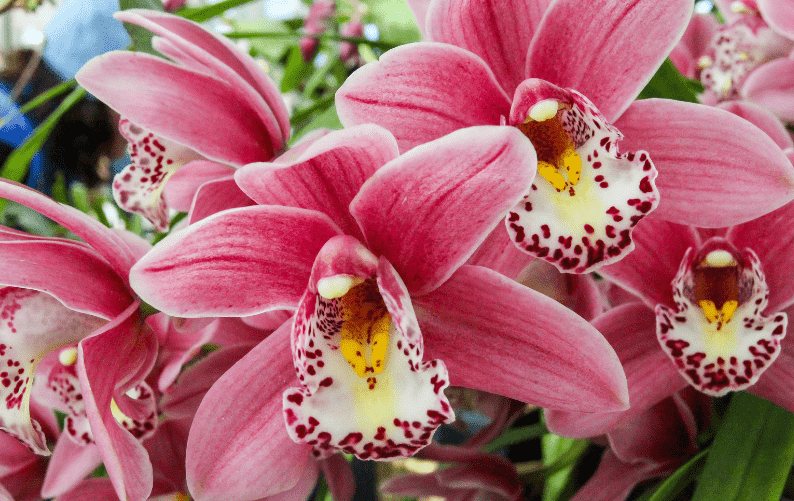
Cut off any damaged or sickly spikes just above the nodes. The same goes for unhealthy leaves. Either trim off the damaged portion, or cut off the entire leaf just above the base of the plant.
To repot an orchid successfully:
*Head to this post for exact step by step instructions on how to repot orchids!
Remove it from its pot and discard the old potting medium. Then, carefully trim away any dead or damaged roots. Next, hold the plant in place in its new larger pot that has drainage holes and fill around the roots with fresh potting mix.
Lightly tamp down the mix, leaving about one inch of headspace. Add more potting mix if needed. If the plant is not sturdy, use stakes until the roots are anchored in place.
Find my favorite orchid pots here!
Propagating
A plant’s natural process of survival and propagation is through its production of seed. While some growers may opt to start from seed, it is usually easier and more convenient to propagate by vegetative means. Especially if a grower is trying to build their orchid collection and has a personal favorite variety they would like to clone exactly.
Monopodial orchids, like Phalaenopsis and Vanda varieties, grow aerial roots from their tall singular stem. They also produce baby plants called Keiki from the nodes at the base of their stem.
Aerial roots can be gently trimmed from the main stalk and planted in a new container. The roots will take hold and after some time a new plant will emerge.
After Keiki develop leaves and grow roots of a couple inches they are ready to be cut away from the main plant. Repot them as you normally would, but into a more size appropriate container.
Sympodial orchids grow from a long horizontal stem called a rhizome. Pseudobulbs sprout from the top of the rhizome and roots shoot out from the bottom.
Cymbidium, Dendrobium and Cattleya are all common sympodial species. Division, back bulb propagation and stem cutting propagation are methods used with sympodial orchids.
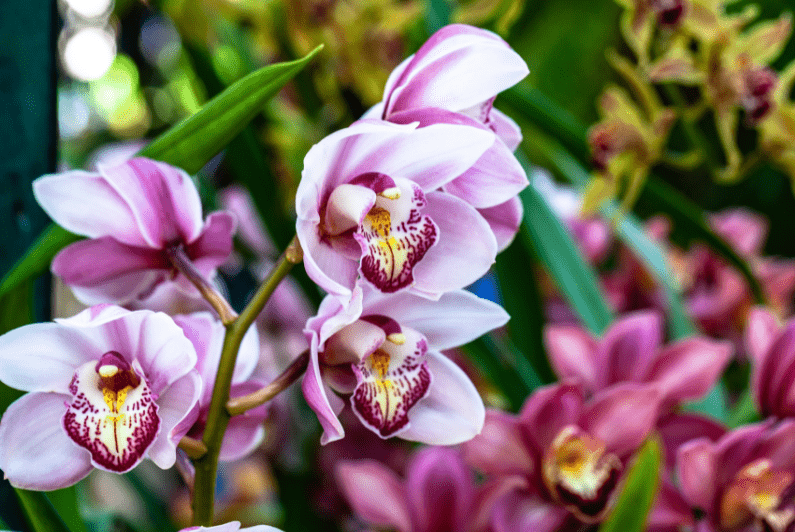
Identify a large, mature plant for division. In most cases the rhizome will have a place where it will split or pull apart naturally. Otherwise, use a sharp knife or shears to cut the rhizome. Make sure each section is about 3-4 inches and has at least a few established pseudobulbs. Remove any dead roots or leaves and repot each section individually.
Back bulb propagation is an extremely effective way to clone favorite plants, but patience is required. New growth from active eyes will be tiny sprouts that can take years to reach maturity.
Remove pseudobulbs that are no longer producing roots or flowers and replant them separately. Some may regrow within a few weeks, other times it may take years for the bulb to rejuvenate.
Finally, sympodial orchids can be propagated by stem cuttings. When a plant has completed its flowering, cut a foot long stem at its base with a knife or scissors.
Divide the stem into 2-3 inch pieces. Each section must have a node or area of new growth in order to sprout a new plant. Lay the pieces in moist sphagnum moss until new shoots emerge.
FAQ
Regularly pruning your orchids every time the blossoms fade and fall off will prepare the plant for a strong rebloom.
Moving your orchid plant to a cooler location during the dormant season will simulate its natural environment and may help trigger an earlier return to blooming. But pay attention to your variety’s individual bloom cycle.
Flowering requires a lot of energy and the rest period is critical to overall plant health.
Some growers leave their plants as is after the flowers fall off. Inspect the spikes at this point. It’s advisable to prune them in some fashion.
Either cut down to the first node to encourage growth, or remove the spike at the base of the plant if it seems spent. This will help the plant conserve energy and signal the restart of the blooming process.
If you love orchids, here’s some of the best places to buy them and the best pots for orchids!
Looking for more orchid fun? Head on over to these posts!


Your info on Orchids is very informative! Great reading!